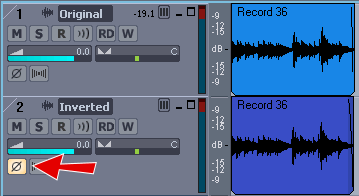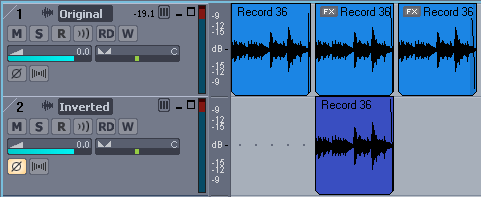 As amateurs, learning to use effects like reverb and compression, we’re often told “bring the effect up until it’s just noticeable in the mix.” Sometimes, this is easier said than done. We’re amateurs after all, and often we haven’t yet learned how an effect is supposed to sound in the mix. How can we judge “just noticeable” when we don’t know what we’re listening for?
As amateurs, learning to use effects like reverb and compression, we’re often told “bring the effect up until it’s just noticeable in the mix.” Sometimes, this is easier said than done. We’re amateurs after all, and often we haven’t yet learned how an effect is supposed to sound in the mix. How can we judge “just noticeable” when we don’t know what we’re listening for?
Practice and experience are the sure-fire methods, of course. But if your recording environment lets you invert the phase of a track, there’s a simple trick you can use to make small changes more obvious.
Because of phase cancellation, when you mix a track with a phase-inverted copy of itself, the two tracks cancel each other out and you hear silence.
However, if you then make a small change to one of the tracks, they’ll no longer cancel each other completely. Instead you’ll hear the parts that don’t cancel out, or effectively the difference between the two tracks. You can use this to hear when an effect has altered the sound of a track by even the smallest “just noticeable” amount.
The concept is straightforward: By mixing the effected track with an inverted copy of the original, you’ll hear the difference introduced by the effect.
And the process for applying this concept is straightforward too: Duplicate the audio track, and invert the phase of the second track. (Like this, in Sonar)

Note the phase-invert button on the second track has been activated. In most DAWs, including Sonar and Cubase, the phase-invert button is denoted by the greek letter phi. As stated above, if you play the two tracks at this point you’ll hear nothing, since they cancel each other out.
Now, on the first track, add the effect you wish to monitor. Adjust the effect a small amount. As you raise its level, the two tracks will increasingly differ, and since they no longer completely cancel each other out, you’ll hear that difference.
Further, you can mute the second track to remove the phase cancellation altogether, and hear how the first track sounds with the effect applied. With some practice, flipping between the original track, the effected track, and the combination which highlights the difference, you’ll get better at judging when an effect is just noticeable.
Here’s a contrived example illustrating the process I used to convince myself that Magneto, a tape emulator, was in fact altering the sound of the tracks I applied it to. (Here’s a screenshot of the Magneto settings I used.)
The clip contains 3 repetitions of a riff, as shown below. First, it’s the original riff. Then, with the effect applied, we hear the “phase cancelled” difference between both tracks. (So clearly, Magneto does something!)
And finally, we hear the effected riff, with no cancellation.

One last note: In the unlikely event that your DAW doesn’t have a phase-invert button, Flipper is a free VST plugin that will do the job for you.
For more home recording tips,
Subscribe to the Hometracked feed, or receive email updates.
Tags: freeplugins, hearing, mixing, phase

1 comment
Trackback URI Comments feed for this article
Awesome article and website! Kudos!